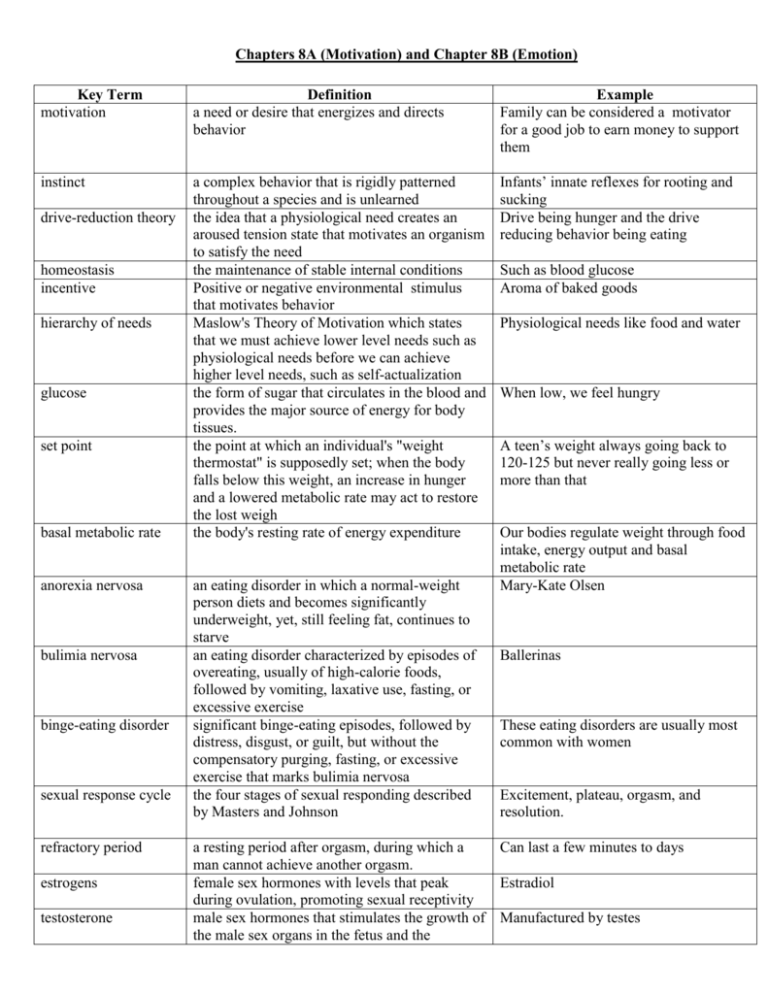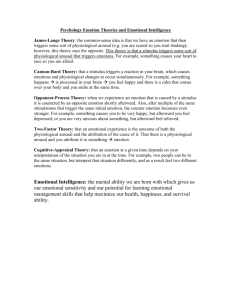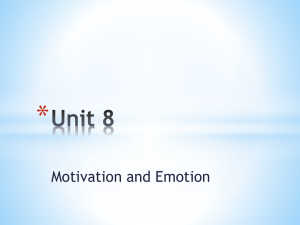vocabulary_for_chapter_8
advertisement

Chapters 8A (Motivation) and Chapter 8B (Emotion) Key Term motivation Definition a need or desire that energizes and directs behavior Example Family can be considered a motivator for a good job to earn money to support them instinct a complex behavior that is rigidly patterned throughout a species and is unlearned the idea that a physiological need creates an aroused tension state that motivates an organism to satisfy the need the maintenance of stable internal conditions Positive or negative environmental stimulus that motivates behavior Maslow's Theory of Motivation which states that we must achieve lower level needs such as physiological needs before we can achieve higher level needs, such as self-actualization the form of sugar that circulates in the blood and provides the major source of energy for body tissues. the point at which an individual's "weight thermostat" is supposedly set; when the body falls below this weight, an increase in hunger and a lowered metabolic rate may act to restore the lost weigh the body's resting rate of energy expenditure Infants’ innate reflexes for rooting and sucking Drive being hunger and the drive reducing behavior being eating drive-reduction theory homeostasis incentive hierarchy of needs glucose set point basal metabolic rate anorexia nervosa bulimia nervosa binge-eating disorder sexual response cycle refractory period estrogens testosterone an eating disorder in which a normal-weight person diets and becomes significantly underweight, yet, still feeling fat, continues to starve an eating disorder characterized by episodes of overeating, usually of high-calorie foods, followed by vomiting, laxative use, fasting, or excessive exercise significant binge-eating episodes, followed by distress, disgust, or guilt, but without the compensatory purging, fasting, or excessive exercise that marks bulimia nervosa the four stages of sexual responding described by Masters and Johnson Such as blood glucose Aroma of baked goods Physiological needs like food and water When low, we feel hungry A teen’s weight always going back to 120-125 but never really going less or more than that Our bodies regulate weight through food intake, energy output and basal metabolic rate Mary-Kate Olsen Ballerinas These eating disorders are usually most common with women Excitement, plateau, orgasm, and resolution. a resting period after orgasm, during which a Can last a few minutes to days man cannot achieve another orgasm. female sex hormones with levels that peak Estradiol during ovulation, promoting sexual receptivity male sex hormones that stimulates the growth of Manufactured by testes the male sex organs in the fetus and the sexual orientation emotion James-Lange theory Cannon-Bard theory two-factory theory polygraph facial feedback development of the male sex characteristics during puberty an enduring sexual attraction toward members of either one's own sex (homosexual orientation) or the other sex (heterosexual orientation) a response of the whole organism, involving (1) physiological arousal, (2) expressive behaviors, and (3) conscious experience. theory that our experience of emotion is our awareness of our physiological responses to emotion-arousing stimuli theory that an emotion-arousing stimulus simultaneously triggers physiological responses and the subjective experience of emotion theory that to experience emotion one must be physically aroused and cognitively label the arousal a machine, commonly used in attempts to detect lies, that measures several of the physiological responses accompanying emotion the effect of facial expressions on experienced emotions catharsis Emotional release feel-good, do-good phenomenon people's tendency to be helpful when already in a good mood. well-being self-perceived happiness or satisfaction with life. adaptation-level phenomenon relative deprivation our tendency to form judgments relative to a neutral level defined by our prior experience the perception that we are worse off relative to those with whom we compare ourselves behavioral medicine an interdisciplinary field that integrates behavioral and medical knowledge and applies that knowledge to healthy and disease a subfield of psychology that provides psychology's contribution to behavioral medicine health psychology stress the process by which we perceive and respond to certain events, called stressors, that we appraise as threatening or challenging Homosexual orientation or heterosexual orientation Anger Pounding heart (arousal) then fear (emotion) follows Pounding heart (arousal) and fear (emotion) happens at the same time Pounding heart (arousal) with cognitive label then follows emotion Measures responses such as perspiration and cardiovascular and breathing changes Such as when a facial expression of anger or happiness intensifies feelings of anger or happiness. Venting aggressive energy through action or fantasy relieving aggressive urges Opening a door for someone may encourage them to do a good deed for someone else Used along with measures of objective well-being (for example, physical and economic indicators) to evaluate people's quality of life. Forming judgments on sounds, lights or income Soldiers feeling frustrated over their own promotion rates after seeing many others being promoted; it inflated their expectations health psychology Health psychologists study our emotions and personality influence our risk of disease An example of a stressor could be college applications general adaptation syndrome the body's adaptive response to stress in three states - alarm, resistance, exhaustion coronary heart disease the clogging of the vessels that nourish the heart muscle; the leading cause of death in many developed countries Type A competitive, hard-driving, impatient, verbally aggressive, and anger-prone people Type B easygoing, relaxed people psychophysiological literally, "mind-body" illness; any stress-related illness physical illness, psychoneuroimmunolo the study of how psychological, neural, and gy (PNI) endocrine processes together affect the immune system and resulting health. lymphocytes the two types of white blood cells that are part of the body's immune system Psychologist Walter Cannon Abraham Maslow Philip Bard Paul Ekman William James Carl Lange Stanley Schachter Hans Selye Someone suffering from physical or emotional trauma: Alarm- heart rate zooms; Resistance-temp., blood pressure and respiration remaining high; Exhaustion- more vulnerable to illness Leading cause of death that can be developed from smoking, obesity, a high-fat diet, physical inactivity and an elevated cholesterol level Some AP or Honor Roll students Horizons kids Such as hypertension and some headaches B lymphocytes or T lymphocytes Importance Cannon-Bard theory that implied an emotion-arousing stimulus simultaneously triggers (1) physiological responses and (2) the subjective experience of emotion Psychologist who developed the hierarchy of needs. Along with Walter Cannon, Bard believed that emotions occur separately from (though simultaneously with) the body’s arousal and therefore created the Cannon-Bard theory. Did an experiment where he showed photographs of various facial expressions to people in different parts of the world and asked them to guess the emotion. He believed that facial expressions were associated with the people’s emotions. Proposed the idea that emotions occur as a result of physiological reaction to events that later became known as the James-Lange theory. Suggested the idea that emotions occur as a result of physiological reaction to events that later became known as the James-Lange theory. Experimented on college men with injections of adrenaline to find out whether the spillover effect exists. He also believed that in order to experience emotion one must be physically aroused and cognitively label the arousal. This theory became known as the two-factor theory. Psychologist who studied animals’ reactions to stressors.











